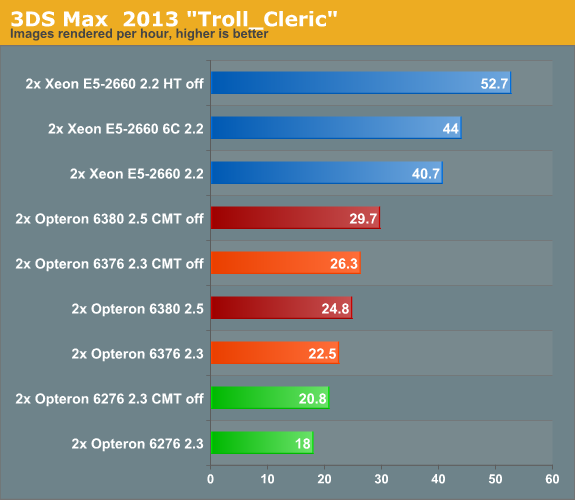The new Opteron 6300: Finally Tested!
by Johan De Gelas on February 20, 2013 12:03 AM EST3DS MAX 2013
Our previous benchmark, the "architecture" scene that is included in the SPEC APC 3DS Max 2007 test, was getting way too old. So we decided to switch to the "Trol_cleric29_max2010" scene while upgrading to 3DS MAX 2013. We render at 1080p (1920x1080) resolution and measure the time it takes to render the first three frames (from 0 to 2). The 64-bit version of 3DS Max 2013 runs on top of 64-bit Windows 2008 R2 SP1. All results are reported as rendered images per hour; higher is thus better.


The results are pretty chaotic at first sight. But the numbers are correct and can be verified by a third party or by yourself for that matter. Let us try to make sense out of this.
First of all, we used the NIVDIA Mental Ray renderer, which despite the "NVIDIA" part in its name is still a CPU only renderer. Secondly, the new benchmark is better than the old one: most of the time all cores are working at very high CPU load: typically 96% and more. However we noticed that without Hyper-Threading and CMT, the CPUs are able to turbo longer and at higher clockspeeds and there are small periods of single threaded action. These two facts together probably explain why disabling Hyper-Threading or CMT improves performance by 20% and more.
Cinebench reports that the Xeon 2660 is 20% faster than the Opteron 6380. In the 3DS Max, the Xeon is up to 77% faster. The new Mental Ray engine seems to be extremely well optimized for the Intel architectures and underperforms on the AMD architecture.
At the end of the day, it is clear that Intel has a huge advantage here, but also that this market is shifting more and more to GPU rendering. This is out of the scope of this article, but many people in the rendering business are using GPU accelerated rendering thanks to NVIDIA's iray renderer. CPU + GPU rendering with iRay seems to outperform Mental Ray in almost all scenes except those with relatively simple lighting, so combining an Intel E5 Xeon with a fast GPU is the best option.










55 Comments
View All Comments
Sivar - Wednesday, February 20, 2013 - link
Please go away. You don't add any new information to the discussion.Your writing is of a teenager who knows nothing of processor architecture, the brilliant engineers at both AMD and Intel, or the competitive landscape.
You present no data, only misinformed opinion. You reduce the quality of this discussion, and have shown no interest in improving your knowledge.
JamesAnthony - Wednesday, February 20, 2013 - link
In the article it mentions you were using the E5-2660 CPU (8 core 2.2 GHz) 95W, in a Dell PowerEdge R720 serverIt may have been a lot more useful to also have included the E5-2680 (8 core 2.7 GHz) and the E5-2690 (8 Core 2.9 GHz) as while they are 130W parts, they are ones that are often used in the PowerEdge R720 and from what we find in a lot of server sales the higher performance ones are very popular for transactional database servers and payment processing servers.
If you want to go head to head on Intel's top part vs AMD's top part, then it would seem it should be the E5-2690 vs 6386 SE
JohanAnandtech - Wednesday, February 20, 2013 - link
We all know that when you want top performance, Intel is the way to go. So I don't really see the point, even AMD will tell you that the 6376 and 6380 are their most competitive parts.. It is pretty obvious that the E5-2690 2.9 GHz will be faster and consume less than a 6386SE. I don't think our readers really need to see numbers on that.And I really doubt that the E5-2690 are sold that much. Most reports say that the top bins with the highest TDP are less than 5% of the total sales.
lwatcdr - Wednesday, February 20, 2013 - link
Wow this is about the most gibberish I have seen in a post ever.Good heavens you are an idiot.
Let's just tear this post bits so this person will NEVER post on here again.
1"No, it's worth per dollar that you have paid to buy Intel based servers. Intel is more reliable because it has Hyperthreading so you can reduce the latencies that will occur in every workloads."
Hyperthreading has nothing to do with reliability. So that was a waste of bandwidth.
"Unlike AMD's engineers who can not design a microprocessor properly. It was AMD's own fault why AMD did not have money like Intel"
My I introduce you to Titan http://www.olcf.ornl.gov/titan/ The worlds most powerful computer and powered by AMD cpus. AKA yea I think that AMD can actually do pretty well at designing CPUs so this part of your post is also pure manure.
"Look 99% Bank's in the world uses Intel based ATM as Intel processor can send information without any error." And here we can see that you understand nothing about digital theory or communications. Again a waste of bandwidth.
"That is why IBM itself does not use Power based processors for its ATM machine because its CEO has admitted that its engineers are not capable to design a lower power processor. So, IBM uses Intel as the standard processor to exchange information between ATM machine to server, so every digits that sent will come in exact same digits when it has been received."
The IBM power line is for high end systems not for ATM machines. Odds are good that many banks use Power based system for handling ATM transactions. IBM uses Intel or AMD because it is cheap and you can get standard boards. As to the every digit sent nonsense. IT IS DIGITAL you MORON. The communications links have error checking and correction not the CPUs. Please NEVER WASTE OUR TIME AGAIN, YOU KNOW NOTHING OF VALUE ON THIS SUBJECT.
toyotabedzrock - Wednesday, February 20, 2013 - link
Something is wrong with the LZMA benchmarks.Can you do a realworld test? There are scripts out there to do this.
LZMA is built around the idea that decompression is supposed to be much faster than compression.
JohanAnandtech - Wednesday, February 20, 2013 - link
From the 7zip manual:"The benchmark shows a rating in MIPS (million instructions per second). The rating value is calculated from the measured speed, and it is normalized with results of Intel Core 2 CPU with multi-threading option switched off. "
So that is the reason why the compression MIPS values are in the same order as the decompression. The decompression "MB/s" values are indeed about 10x and more higher than compression.
Oldboy1948 - Thursday, February 21, 2013 - link
It is an interesting bench and if cache and memory are fast decompress and compress will be very close. It looks better for Bulldozer in this:http://www.7-cpu.com/
ARM has a long way to go if it will be a server one day.
extide - Wednesday, February 20, 2013 - link
Can we PLEASE get folding@home benches?! musky on the hardocp forums has come up with a system where you can run repeatable benchmarks. Myself as well as many others would really love to see F@H benches on systems like this!JohanAnandtech - Wednesday, February 20, 2013 - link
Ok, Link? :-)alpha754293 - Wednesday, February 20, 2013 - link
Because of the way that the current Opteron architecture is (1 FPU per module), did you run with the number of LS-DYNA processes equal to the number of FPUs on chip or did you run it based on per "core" (i.e. 2 processes per module)?